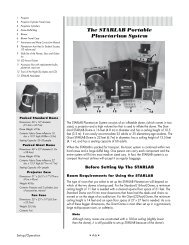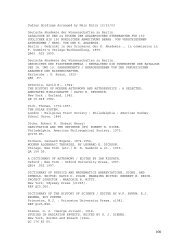K-6 Activities - Dudley Observatory
K-6 Activities - Dudley Observatory
K-6 Activities - Dudley Observatory
You also want an ePaper? Increase the reach of your titles
YUMPU automatically turns print PDFs into web optimized ePapers that Google loves.
Making Constellation Slides<br />
Procedure<br />
• Use processed black 35mm slides (or slides you took when you thought there<br />
was enough light) to make constellation slides. Place the black slides on a soft<br />
surface such as a magazine. Using a needle, poke small holes in the slide at<br />
locations corresponding to star positions in the constellations.<br />
• A shoe box makes a good projector for constellation slides made out of black<br />
construction paper. If each student made a projector and a slide you would have<br />
some good material for a quiz. Cut the end out of a shoe box and two slots on<br />
each side to allow a piece of black construction paper, with pin holes in the form<br />
of a constellation, to slide through. Place a flashlight on the inside of the box or<br />
cut out the other end of the box to allow light to pass through the pin holes.<br />
• Clear transparencies with the constellations drawn on them is a simple way to<br />
project the stars.<br />
• Have several students draw stars (small dots for small circles) hit or miss on the<br />
chalkboard so that the board is quite full of “stars” in the “sky.” The students<br />
may use a piece of plain white paper and fill their “sky” full of “stars” and then<br />
exchange their paper with another student. Ask the children to see if they could<br />
join some together with a line and tell what this picture reminds them of.<br />
Lost in Space<br />
Note<br />
The purpose of this activity is to become familiar with the facts about the<br />
universe.<br />
Procedure<br />
• The class is to be divided into two teams of equal ability.<br />
• Each team elects a captain who will be responsible for giving the team answer.<br />
The first player on Team A gives a one-sentence description of where he is; for<br />
example: “I am on a planet that has four moons.” The players on Team B have<br />
up to three team guesses to guess where player on Team A is. If they guess correctly,<br />
the player from Team A is captured and becomes a member of Team B.<br />
If they do not guess correctly, the first player from Team B describes where he is<br />
and the players from Team A do the guessing. The team with the most players at<br />
the end of the allotted time is declared the winner.<br />
• It would be helpful to the students to give them a little time to do some research<br />
on their own location. To avoid errors, the pupil who gives the description<br />
might be requested to write the correct answer to where he is lost and allow the<br />
teacher to check it, to insure that his clue description is correct.<br />
• B–83 • K–6 <strong>Activities</strong>





